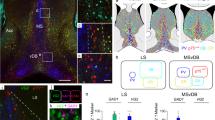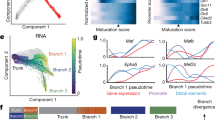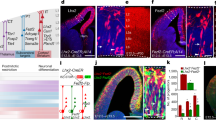Abstract
During neural development in vertebrates, a spatially ordered array of neurons is generated in response to inductive signals derived from localized organizing centres. One organizing centre that has been proposed to have a role in the control of neural patterning is the roof plate. To define the contribution of signals derived from the roof plate to the specification of neuronal cell types in the dorsal neural tube, we devised a genetic strategy to ablate the roof plate selectively in mouse embryos. Embryos without a roof plate lack all the interneuron subtypes that are normally generated in the dorsal third of the neural tube. Using a genetically based lineage analysis and in vitro assays, we show that the loss of these neurons results from the elimination of non-autonomous signals provided by the roof plate. These results reveal that the roof plate is essential for specifying multiple classes of neurons in the mammalian central nervous system.
This is a preview of subscription content, access via your institution
Access options
Subscribe to this journal
Receive 51 print issues and online access
$199.00 per year
only $3.90 per issue
Buy this article
- Purchase on Springer Link
- Instant access to full article PDF
Prices may be subject to local taxes which are calculated during checkout







Similar content being viewed by others
References
Harland, R. & Gerhart, J. Formation and function of Spemann's organizer. Annu. Rev. Cell. Dev. Biol. 13, 611–667 (1997).
Pearse, R. V. & Tabin, C. J. The molecular ZPA. J. Exp. Zool. 282, 677–690 (1998).
Martin, G. R. The roles of FGFs in the early development of vertebrate limbs. Genes Dev. 12, 1571–1586 (1998).
Bei, M. & Maas, R. FGFs and BMP4 induce both Msx1-independent and Msx1-dependent signaling pathways in early tooth development. Development 125, 4325–4333 (1998).
Shamim, H. et al. Sequential roles for Fgf4, En1 and Fgf8 in specification and regionalisation of the midbrain. Development 126, 945–959 (1999).
Dodd, J., Jessell, T. M. & Placzek, M. The when and where of floor plate induction. Science 282, 1654–1657 ( 1998).
Lee, K. J. & Jessell, T. M. The specification of dorsal cell fates in the vertebrate central nervous system. Annu. Rev. Neurosci. 22, 261–294 ( 1999).
Liem, K. F. Jr, Tremml, G., Roelink, H. & Jessell, T. M. Dorsal differentiation of neural plate cells induced by BMP-mediated signals from epidermal ectoderm. Cell 82, 969–979 (1995).
Liem, K. F. Jr, Tremml, G. & Jessell, T. M. A role for the roof plate and its resident TGFβ-related proteins in neuronal patterning in the dorsal spinal cord. Cell 91, 127–138 ( 1997).
Lee, K. J., Mendelsohn, M. & Jessell, T. M. Neuronal patterning by BMPs: a requirement for GDF7 in the generation of a discrete class of commissural interneurons in the spinal cord. Genes Dev. 12, 3394– 3407 (1998).
Palmiter, R. D. et al. Cell lineage ablation in transgenic mice by cell-specific expression of a toxin gene. Cell 50, 435 –443 (1987).
Breitman, M. L. et al. Genetic ablation: targeted expression of a toxin gene causes microphthalmia in transgenic mice. Science 238, 1563–1565 (1987).
Grieshammer, U., Lewandoski, M., Prevette, D., Oppenheim, R. W. & Martin, G. R. Muscle-specific cell ablation conditional upon Cre-mediated DNA recombination in transgenic mice leads to massive spinal and cranial motoneuron loss. Dev. Biol. 197, 234–247 (1998).
Maxwell, I. H., Maxwell, F. & Glode, L. M. Regulated expression of a diphtheria toxin A-chain gene transfected into human cells: possible strategy for inducing cancer cell suicide. Cancer Res. 46, 4660–4664 (1986).
Rajewsky, K. et al. Conditional gene targeting. J. Clin. Invest. 98, 600–603 (1996).
Sauer, B. Inducible gene targeting in mice using the Cre/lox system. Methods 14, 381–392 ( 1998).
Dietrich, P., Dragatsis, I., Xuan, S., Zeitlin, S. & Efstratiadis, A. Conditional mutagenesis in mice with heat shock promoter-driven cre transgenes. Mamm. Genome (in the press).
Christians, E., Campion, E., Thompson, E. M. & Renard, J. P. Expression of the HSP 70. 1 gene, a landmark of early zygotic activity in the mouse embryo, is restricted to the first burst of transcription. Development 121, 113–122 (1995).
Lyons, K. M., Hogan, B. L. & Robertson, E. J. Colocalization of BMP 7 and BMP 2 RNAs suggests that these factors cooperatively mediate tissue interactions during murine development. Mech. Dev. 50, 71–83 (1995).
Dudley, A. T. & Robertson, E. J. Overlapping expression domains of bone morphogenetic protein family members potentially account for limited tissue defects in BMP7 deficient embryos. Dev. Dyn. 208, 349–362 (1997).
Parr, B. A., Shea, M. J. & McMahon, A. P. Mouse Wnt genes exhibit discrete domains of expression in its early embryonic CNS and limb buds. Development 119, 247–261 (1993).
Hill, R. E. et al. A new family of mouse homeo box-containing genes: molecular structure, chromosomal location, and developmental expression of Hox-7. 1. Genes Dev. 3, 26–37 (1989).
Robert, B., Sassoon, D., Jacq, B., Gehring, W. & Buckingham, M. Hox7, a mouse homeobox gene with a novel pattern of expression during embryogenesis. EMBO J. 8, 91–100 (1989).
Nagai, T. et al. The expression of the mouse Zic1, Zic2, and Zic3 genes suggests an essential role for Zic genes in body pattern formation. Dev. Biol. 182, 299–313 ( 1997).
Dickinson, M. E., Selleck, M. A., McMahon, A. P. & Bronner, F. M. Dorsalization of the neural tube by the non-neural ectoderm. Development 121, 2099–2106 ( 1995).
Selleck, M. & Bronner-Fraser, M. Origins of the avian neural crest; the role of neural plate–epidermal interactions. Development 121, 525–538 (1995).
Labosky, P. A. & Kaestner, K. H. The winged helix transcription factor Hfh2 is expressed in neural crest and spinal cord during mouse development. Mech. Dev. 76, 185–190 (1998).
Ma, Q., Fode, C., Guillemot, F. & Anderson, D. J. Neurogenin1 and neurogenin2 control two distinct waves of neurogenesis in developing dorsal root ganglia. Genes Dev. 13, 1717– 1728 (1999).
Jones, C. M., Lyons, K. M. & Hogan, B. L. Involvement of Bone Morphogenetic Protein-4 (BMP-4) and Vgr-1 in morphogenesis and neurogenesis in the mouse. Development 111, 531–542 ( 1991).
Arkell, R. & Beddington, R. S. P. BMP7 influences pattern and growth of the developing hindbrain of mouse embryos. Development 124, 1–12 ( 1997).
Roelink, H. & Nusse, R. Expression of two members of the Wnt family during mouse development: restricted temporal and spatial patterns in the developing neural tube. Genes Dev. 5, 381–388 (1991).
Snow, D. M., Steindler, D. A. & Silver, J. Molecular and cellular characterization of the glial roof plate of the spinal cord and optic tectum: a possible role for a proteoglycan in the development of an axon barrier. Dev. Biol. 138 , 359–376 (1990).
Ericson, J., Morton, S., Kawakami, A., Roelink, H. & Jessell, T. M. Two critical periods of Sonic Hedgehog signaling required for the specification of motor neuron identity. Cell 87, 661–673 (1996).
Dickinson, M. E., Krumlauf, R. & McMahon, A. P. Evidence for a mitogenic effect of Wnt-1 in the developing mammalian central nervous system. Development 120, 1453–1471 (1994).
Ikeya, M., Lee, S. M. K., Johnson, J. E., McMahon, A. P. & Takada, S. Wnt signalling required for expansion of neural crest and CNS progenitors. Nature 389, 966–970 (1997).
Ericson, J. et al. Pax6 controls progenitor cell identity and neuronal fate in response to graded Shh signaling. Cell 90, 169–180 (1997).
Akazawa, C., Ishibashi, M., Shimizu, C., Nakanishi, S. & Kageyama, R. A mammalian helix–loop–helix factor structurally related to the product of the Drosophila proneural gene atonal is a positive transcriptional regulator expressed in the developing nervous system. J. Biol. Chem. 270, 8730– 8738 (1995).
Helms, A. W. & Johnson, J. E. Progenitors of dorsal commissural interneurons are defined by Math1 expression. Development 125, 919–928 (1998).
Ma, Q., Kintner, C. & Anderson, D. J. Identification of neurogenin, a vertebrate neuronal determination gene. Cell 87, 43 –52 (1996).
Lo, L. C., Johnson, J. E., Wuenschell, C. W., Saito, T. & Anderson, D. J. Mammalian achaete-scute homolog 1 is transiently expressed by spatially restricted subsets of early neuroepithelial and neural crest cells. Genes Dev. 5, 1524 –1537 (1991).
Bronner-Fraser, M. & Fraser, S. E. Cell lineage analysis reveals multipotency of some avian neural crest cells. Nature 335, 161–164 ( 1988).
O'Gorman, S., Fox, D. T. & Wahl, G. M. Recombinase-mediated gene activation and site-specific integration in mammalian cells. Science 251, 1351–1355 (1991).
Tsien, J. Z. et al. Subregion- and cell type-restricted gene knockout in mouse brain. Cell 87, 1317–1326 (1996).
Soriano, P. Generalized lacZ expression with the ROSA26 Cre reporter strain. Nature Genet. 21, 70–71 (1999).
Yamaizumi, M., Mekada, E., Uchida, T. & Okada, Y. One molecule of diphtheria toxin fragment A introduced into a cell can kill the cell. Cell 15, 245–250 ( 1978).
Millonig, J. H., Millen, K. J. & Hatten, M. E. The mouse dreher gene (Lmx1a) controls formation of the roof plate in the vertebrate CNS. Nature 403, 764–769 (2000).
Tanabe, Y. & Jessell, T. M. Diversity and pattern in the developing spinal cord. Science 274, 1115– 1123 (1996).
Ding, Q. et al. Diminished Sonic hedgehog signaling and lack of floor plate differentiation in Gli2 mutant mice. Development 125, 2533 –2543 (1998).
Matise, M. P., Epstein, D. J., Park, H. L., Platt, K. A. & Joyner, A. L. Gli2 is required for induction of floor plate and adjacent cells, but not most ventral neurons in the mouse central nervous system. Development 125, 2759–2770 (1998).
Beattie, C. E. et al. Temporal separation in the specification of primary and secondary motoneurons in zebrafish. Dev. Biol. 187, 171–182 (1997).
Acknowledgements
We thank A. Efstratiadis for the Hs–cre strain; B. Han and M. Mendelsohn for help with cell culture and generation of mouse strains; S. Kaplan for technical assistance; D. Anderson, J. Johnson, K. Kaestner, A. Pierani, P. Soriano and E. Turner for mouse strains and reagents; J. Millonig, K. Millen and M. E. Hatten for discussions; R. Axel, J. Briscoe, N. Shah and L. Vosshall for comments on the manuscript; and K. MacArthur for help in its preparation. K.J.L. was an HHMI Fellow of the Life Sciences Research Foundation. The work of P.D. was supported by an NIH grant to A. Efstratiadis. T.M.J. was supported by grants from the NIH and is an Investigator of the Howard Hughes Medical Institute.
Author information
Authors and Affiliations
Corresponding author
Rights and permissions
About this article
Cite this article
Lee, K., Dietrich, P. & Jessell, T. Genetic ablation reveals that the roof plate is essential for dorsal interneuron specification. Nature 403, 734–740 (2000). https://doi.org/10.1038/35001507
Received:
Accepted:
Issue Date:
DOI: https://doi.org/10.1038/35001507
This article is cited by
-
Notch signaling is a critical initiator of roof plate formation as revealed by the use of RNA profiling of the dorsal neural tube
BMC Biology (2021)
-
Injured adult motor and sensory axons regenerate into appropriate organotypic domains of neural progenitor grafts
Nature Communications (2018)
-
Noggin inactivation affects the number and differentiation potential of muscle progenitor cells in vivo
Scientific Reports (2016)
Comments
By submitting a comment you agree to abide by our Terms and Community Guidelines. If you find something abusive or that does not comply with our terms or guidelines please flag it as inappropriate.



